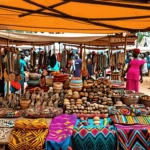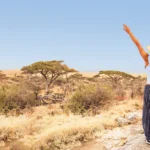At dawn, the golden savannah light spills across the rolling plains of the Mara. A group of Maasai herders leads their cattle slowly back to their manyattas as safari jeeps head out in the opposite direction, engines humming toward a pride of lions that had been roaring through the night. This delicate balance of tradition and tourism is the living heart of the Maasai Mara’s conservancies a uniquely Kenyan experiment in community-led conservation that is reshaping how people and wildlife share space.
What Are Conservancies?
Conservancies are community-owned lands that Maasai families lease to wildlife trusts, which then partner with tourism operators. Instead of fragmenting land through subdivision or fencing, conservancies pool thousands of acres into contiguous habitat. Families receive monthly lease payments, employment opportunities, and access to community projects, while wildlife gains safe corridors beyond the crowded Maasai Mara National Reserve.
Since the first conservancy Ol Kinyei was established in 2005, the model has spread rapidly. Today, more than 15 registered conservancies cover an estimated 350,000 acres surrounding the reserve, according to the Maasai Mara Wildlife Conservancies Association (MMWCA). Together, they have become a buffer zone that eases pressure inside the reserve while creating one of Africa’s most important experiments in community conservation.
Timeline: How the Mara Conservancies Emerged
- 2005 – Ol Kinyei becomes the first conservancy.
- 2006–2010 – Olare Motorogi, Naboisho and Mara North follow, backed by NGOs and safari camps.
- 2013 – Kenya enacts the Wildlife Conservation and Management Act, providing a policy framework.
- 2015 – MMWCA formally launched as umbrella body.
- 2020 – COVID-19 tourism collapse exposes reliance on park fees.
- 2024 – Over 350,000 acres conserved; new carbon finance pilots begin.
How Conservancies Work
The model is deceptively simple but carefully designed:
- Revenue-sharing: Tourism income flows into conservancy trusts. Typically, 65% is distributed as land lease payments to households, 20% funds management and ranger salaries, and 15% supports community projects such as schools and clinics. Percentages vary, but the principle of split benefit is consistent.
- Governance: Each conservancy elects a committee from among landowners, often with NGO facilitation. Committees negotiate with safari operators, decide on grazing zones, and adjudicate disputes. In strong cases like Olare Motorogi, transparent accounting has built trust. In weaker cases, delayed payments or opaque contracts have sparked tension.
- Tourism caps: To avoid the overcrowding that plagues the reserve, conservancies impose strict rules typically no more than five vehicles per wildlife sighting. For visitors, this means an exclusive safari; for wildlife, less stress and freer movement.
Benefits for People
Lease payments now provide many Maasai families with their first regular cash income. In Naboisho, for example, households reportedly earn the equivalent of $50–80 per month per parcel, dependable regardless of tourism fluctuations. Schools, water projects, and health clinics are among the most visible community dividends. Employment is another pillar: hundreds of rangers, guides, cooks, and camp staff are hired directly from conservancy communities. “I used to herd cattle. Now I herd tourists and lions,” laughs Josephine Nkai, one of the few female rangers in Mara North. Her wages support her siblings’ education, and her presence on patrols is shifting gender norms in a deeply patriarchal setting.
The Tourism Model
For visitors, conservancies offer a high-value, low-impact safari. Lodges operate on long-term leases and charge premium rates, knowing exclusivity is part of the appeal. Guests often cite the intimacy: sundowners with only the sound of cicadas, or a cheetah hunt watched by two jeeps instead of twenty.
Wildlife has responded in kind. Lion prides, cheetahs, and elephants now spend significant time outside the reserve. A 2018 study found that some conservancies hold predator densities equal to or higher than the reserve itself.
Risks & Resilience
But the model is not without fragility. COVID-19 exposed dependence on foreign tourism: lease payments nearly collapsed in 2020, only rescued by emergency donor grants. Climate stress adds another layer prolonged droughts have intensified grazing conflicts, as herders push cattle back into wildlife zones.
Conservancies are experimenting with diversification: carbon credit projects are being piloted in Mara North and Naboisho, promising a new revenue stream for landowners tied to verified forest and grassland carbon storage. Small enterprises beekeeping, cultural tourism, women’s craft collectives are also helping to buffer shocks.
Human-Wildlife Conflict
Living with predators remains a daily challenge. Cattle raids by lions are still recorded, though incident rates are lower in conservancy zones due to active ranger patrols and rapid compensation schemes. In Olare Motorogi, a compensation fund pays households within two weeks of verified livestock loss, reducing retaliatory killings. Still, not all conservancies are equally resourced. Some lag in paying out, leading to simmering resentment. Transparency in these schemes is often the difference between fragile coexistence and renewed hostility.
Policy & Scale
Kenya’s Wildlife Conservation and Management Act (2013) formally recognize conservancies, but land tenure remains complex. Parcels are often registered in men’s names, raising equity issues over how lease income is shared within households. NGOs have begun training women on financial literacy and advocating for joint land titles to secure gender equity. At county level, Narok’s land subdivision pressures remain a major threat. As populations grow, families face temptation to break up leases into small, fenced plots a move that would unravel the landscape connectivity that conservancies depend on. Nationally, conservancies are viewed as a flagship for Kenya’s tourism future. Yet without guaranteed funding or stronger oversight, their survival remains vulnerable to political turnover and fluctuating donor interest.
Case Study: Naboisho Conservancy
- Founded: 2010
- Size: 50,000 acres
- Households: ~600 landowners
- Lease payments: $50–80 per month per household (reported)
- Unique feature: Integrated grazing zones, allowing cattle access on rotation.Naboisho is often held up as a success combining high predator densities with a strong community dividend model.
Table: Selected Mara Conservancies at a Glance
Conservancy Size (acres) Households Special Feature
Ol Kinyei 18,700 ~100 First conservancy; pioneered lease model
Naboisho 50,000 ~600 Zoned grazing plus tourism
Olare Motorogi 33,000 ~277 Strict vehicle caps; luxury lodges
Mara North 74,000 ~850 Community ranger force
The Road Ahead
Conservancies hold immense promise — but they are not a magic bullet. Their sustainability depends on:
- Transparent governance and timely payments.
- Diversified revenue beyond tourism.
- Climate adaptation and conflict mitigation.
- Equitable inclusion of women and youth in decision-making.
As one elder in Naboisho put it: “The lions now pay our children’s school fees. But if we misuse this gift, the lions will go — and so will the money.”
Closing Scene
Back on the plains at dusk, a group of young Maasai rangers gather by a fire. Their radios crackle with reports of a cheetah sighting, while children play nearby, wearing donated school uniforms stitched with images of zebras. It is a reminder that the future of the Mara is not just in the hands of tourists or government ministries, but in the choices of its people.If conservancies can stay accountable, diversify income streams, and adapt to climate stress, the Mara may remain not only one of the world’s great wildlife landscapes — but also a sustained source of local prosperity.
Related Posts
-
Markets of Africa: Where to Buy Authentic, Handmade Treasures
Explore Africa’s vibrant markets and discover authentic, handmade treasures from Ghana’s royal Kente to Tuareg…
-
The death and rebirth of Kenyan football: Pride, policy,and the promise of a new era
On a humid Nairobi evening, matatus blaze their horns in traffic as touts lean out…
-
Solo Travel in Africa: The Best Cities and Tips for Exploring Safely
Thinking about traveling solo in Africa? From Cape Town to Kigali, discover the safest cities,…


